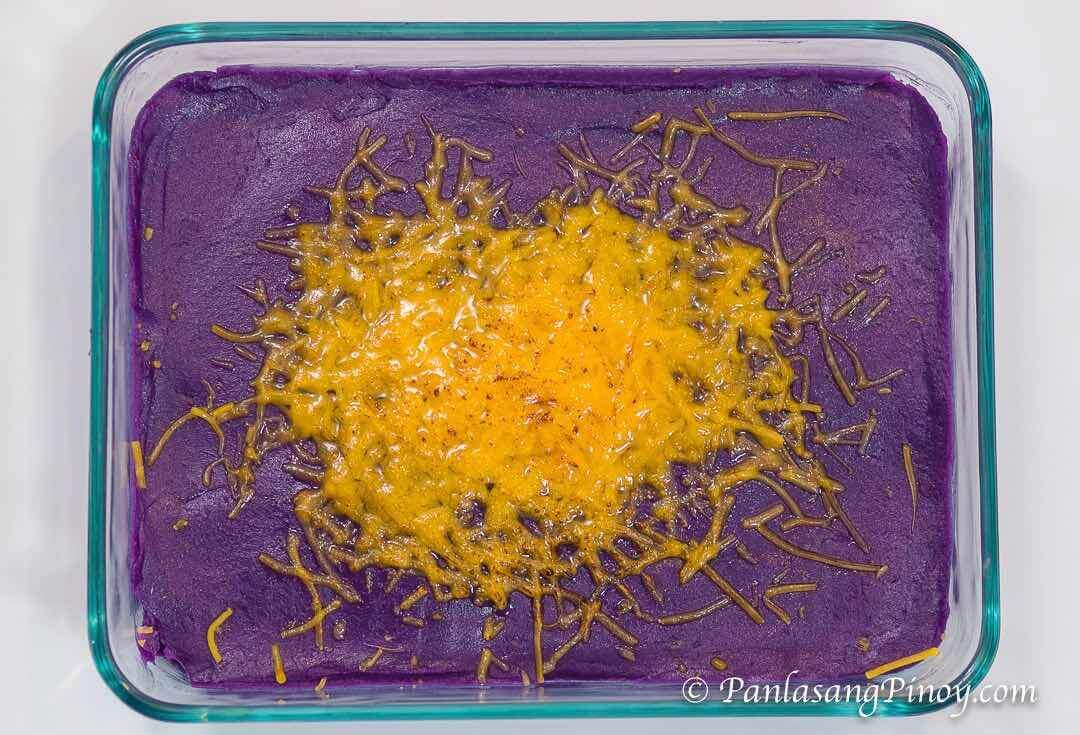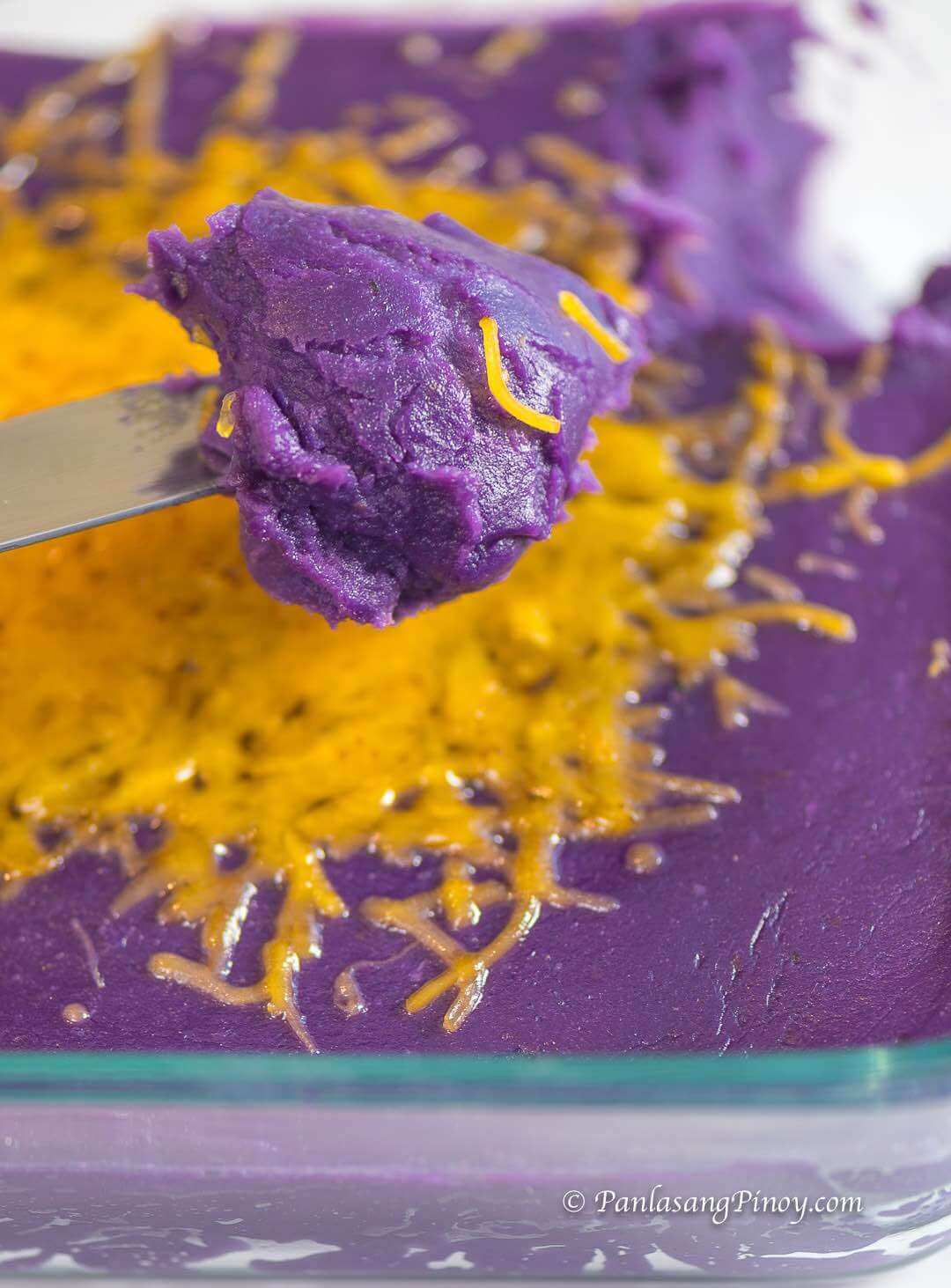Ube Halaya with Cheese
From leche flan to halo-halo, the Philippines is anything but short of delicious local desserts to try. We love to experiment with various sugary ingredients to find that perfect balance of flavor. And with its comfortingly velvety texture and mildly sweet taste, Ube Halaya is among those deliciously well-balanced desserts. Some people also call it ube jalea, ube jam or ube haleya. But they all stand for the same consistently creamy and delicious dessert.

Essentially, we make it by cooking up some ube or purple yams. Then we add some milk and sugar into the mix to create that unmistakable sticky and smooth texture. We can usually find it in a llanera or an oval-shaped metal container where you’d also find your leche flan. But for this recipe, we’ll be keeping it simple by making it in a cooking pot.
This recipe can also be considered somewhat of an upgrade. This is because includes the delightful savory taste of cheddar cheese as a topping. Complementary to the mild sweetness of our ube, the flavors are a match made in heaven, only making this dessert even more irresistible.
But it is also popularly served with some latik or slightly crispy coconut bits. These add a degree of toasty sweetness to the dish. If you’d prefer to have your Ube Halaya with this on top, feel free to check out my recipe for this.
And because of just how perfectly poised our mix of flavors is in Ube Halaya, it also works when put alongside various other desserts.
What can I eat this with?
We’ve already got a pretty great blend of flavors in Ube Halaya. This is why it also works great as a standalone dessert. Many have said that this tastes particularly well with a cup of decadent, rich hot chocolate on a cold day. But you could also have it with some ginger tea or salabat. This can help contrast your sweetness with a bit of spice.
But you can also have fun with this versatile dish by incorporating it with other ingredients. Getting tired of your peanut butter sandwiches? You can lather on a delicious amount of this on your bread. After all, it also works really well as a spread. This gives you a bit more of a hearty meal to have with your yummy ube-infused jam.
And if you’re looking to get even more creative with this, you can try making some ube ice cream with this jam and some whole milk. And it’d be easier to create some thick, creamy ube cheesecake with this jam, instead of starting off with whole purple yams. Essentially, the possibilities are endless for this simple, but delicious dish! No wonder it has become somewhat of a household name. But what are the actual origins of Ube Halaya?
How did Ube Halaya become such a famed Filipino dish?
The exact origins of this dish actually remains much of a mystery as of today. This is because food historians have said that the beginnings of ube as a dessert ingredient was not recorded or written down on paper. And so when and how it was specifically invented is yet to be confirmed. In 1918, a recipe for jalea de calabaza or pumpkin jam popped up in the second earliest Filipino cookbook. But ube halaya was left out of the pages. However, the process described for pumpkin jam seems to be similar to what they would probably also do with ube for halaya.
But many believe that the classic recipe for this actually makes use of fresh carabao’s milk. They soon replaced this with some other ingredients like condensed milk and evaporated milk when these came to the Philippines. During the American colonization period, they brought over such components, which made the cooking process easier, and the dessert generally sweeter.
Today, the recipe can differ among cooks, but I like to use a mix of condensed milk, coconut milk and some butter for the dairy component in the actual Ube Halaya mixture.
Let’s make some subtly sweet and delicious Ube Halaya!
For this recipe, we’ll be making enough servings of yummy Ube Halaya for 4. Start out by grabbing a cooking pot, and pour 2 cups of coconut milk inside. Let this boil, and then stir this thoroughly. Now pour 114 ounces of canned condensed milk inside for an added creaminess.
When your mixture has begun to boil, incorporate 1 pound of purple yam that you’ve grated, as well as 1 teaspoon of ube flavoring. Keep your mixture cooking for about 30 more minutes in medium heat. Make sure to stir this continuously as it cooks.
After the half hour has passed, place 3 tablespoons of butter, and stir the mixture. Continue to cook this until you can see that your mixture has become as thick as you’d prefer your ube halaya to be. For me, I keep the pot cooking for about 10 to 12 minutes more after I’ve added my butter.
Once you’ve got all of those steps covered, feel free to place your vibrant, purple mixture on your container of choice. Arrange ½ cup of shredded cheddar cheese on top to fully achieve that Ube Halaya with cheese look! Feel free to have this for your dessert, or use it as a spread, as previously mentioned.
How should I store my Ube Halaya?
You can actually keep your freshly cooked Ube Halaya fresh for about 5 more days by keeping it in the refrigerator. But after you’ve cooked it, make sure that you wait for it to cool down to room temperature before you place it inside.

But what if you want it to last longer than 5 days? Perhaps there are a couple of upcoming events you’d like to bring this homemade dish to. The good news is, you can still freeze this to have it good for consumption much longer. You can use a small airtight container for your Ube Halaya. Then place this in your freezer, and it should last for about two months!
When you’re ready to have it again, this can also taste pretty good when chilled. But you can also opt to wait for it to go down to room temperature to have it in its regular texture. And if you want to have a go at similar dishes or fellow Filipino desserts for the future, keep reading for a couple of my recommendations!
Try whipping up a couple of these Filipino desserts as well!
Ube Biko
If you’ve ever tried Biko, a sugary and sticky local rice cake, you are probably familiar with most of the charms of this dish. It’s sweet, fulfilling, and delightfully milky. But the twist that comes with Ube Biko is right in the name, and it’s in the addition of that lovely Filipino favorite of an ingredient. Like our original recipe, this dish has some ever-delicious purple yams at its center.
Because of this, you get less of the somewhat toffee-like taste of brown sugar. Instead, the gentle, subtly sweet taste of ube takes center stage for this dish. And while it already excels taste-wise, you also get the lovely advantage of its vibrant visual appeal. Serve this on your dinner table to impress guests with a beautiful plate of purple, coconut-y heaven!
Ube Kalamay
A recurring ingredient you might see in various Filipino dishes– from sweet to savory– is coconut. But this beloved fruit is not only popular because of its accessibility, and how much it flourishes in the country. It also provides some subtle, but delectable notes of flavor to various dishes. And for our Ube Kalamay, it mixes deliciously with our grated purple yam and its vanilla-like flavor.
Just like the previous recipe, it is a sweet and sticky dessert made with rice flour. But it’s got a one of a kind consistency that makes it such a distinctively good dish for those special occasions and fiestas.
Ube Pichi Pichi
It’s smaller size and just right mix of flavors makes Ube Pichi Pichi just the perfect dessert snack to continuously pop into your mouth. But after a couple of munches, you might just be shocked by how full you’ll get because of the wealthy amount of grated cassava and coconut this dish has got. This is the kind of meryenda that can stand alone because of just how naturally filling it is.
The process of making this dish can also be really fun, as it involves a great deal of steaming. If you’ve got a bamboo steamer at your disposal, this would be a fantastic recipe to try. The steps towards this dish are also fairly simple, as you’ll mainly be mixing, waiting to steam, and then coating your yummy pichi pichi pieces in shredded coconut. Serve this on your next picnic or gathering for a tasty and sweet local treat!
Yema
Reminiscent of childhood memories of receiving some of these cellophane-covered goodies from grandmothers or buying them from the school canteen, yema is definitely a well-loved Filipino snack. But even if it might remind most of their younger days, this is a dessert that people of many ages truly enjoy. Despite how we essentially only use two different types of ingredients for this, the taste we form through this combination is absolutely delicious.
With a mildly nutty taste, and a sugary flavor, the yema candy appeals to most, Filipino or not. This is why you should definitely try your hand at making some of these at home. It is the perfect snack to give to family, friends and other guests! Just make sure to also get your hands on some colorful cellophane wrapping to provide the full experience.
What did you think of these recipes, and of course, our Ube Halaya dish? Comment below if you’ve got any feedback or suggestions you’d like to share!
Ube Halaya with Cheese
This is a recipe for Ube Halaya with Cheese
Ingredients
- 1 lb. grated purple yam
- 1 14 oz. can condensed milk
- 2 cups coconut milk
- 3 tablespoons butter
- 1 teaspoon ube flavoring
- 1/2 cup shredded cheddar cheese
Instructions
-
Pour coconut milk in a cooking pot. Let boil.
-
Stir and add the condensed milk.
-
Once the mixture starts to boil, add the grated purple yam and ube flavoring. Continue to cook in medium heat while continuously stirring for 30 minutes.
-
Add butter. Stir. Cook until the mixture reaches your desired thickness. (I usually cook it for 10 to 12 minutes after adding butter).
-
Transfer to a container. Top with shredded cheese.
-
Serve. Share and enjoy!
Nutrition
Serving: 4g
Watch how to cook it
[embedded content]
